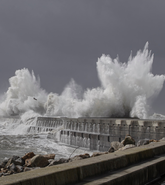NEWARK, CA – November 13, 2023 – Moody’s RMS®, the leading risk modeling and solutions company, estimates private market insured losses from Hurricane Otis to be between US$2.5 billion and US$4.5 billion. This estimate represents insured losses associated primarily with wind damage in the devastating Category 5 hurricane that made landfall in Acapulco, Mexico.
The estimate reflects property damage and business interruption losses to residential, commercial, industrial, and automobile lines of business, and considers the potential for post-event loss amplification (PLA), inflationary trends, and non-modeled sources of loss, including infrastructure damage.
The estimate does not include losses for any sovereign protection programs (i.e. Mexico’s FONDEN) as a result of this event, which includes both traditional (re)insurance and insurance-linked securities.
Wind losses from Otis are based on analysis of ensemble footprints and stochastic events in Moody’s RMS Version 23 North Atlantic Hurricane Models that best reflect the characteristics and uncertainties of the event, and using an internal Moody’s RMS industry exposure database for Mexico.
Moody’s RMS developed and validated the selected events and corresponding loss estimates using publicly available data, including wind station observations, web reconnaissance, and analysis of high-resolution aerial imagery.
Jeff Waters, Staff Product Manager, North Atlantic Hurricane Models, Moody’s RMS, said: “Major Hurricane Otis was an unprecedented event across multiple fronts. As a Category 5 storm with 165 miles per hour (270 kilometers per hour) sustained winds, it was the strongest landfalling hurricane on record in both the Acapulco region and Mexico as a whole, aided by a period of record rapid intensification in the 24 hours prior to landfall."
"Observational windspeed data – while limited – suggests a broad swath of exposure and population was affected by major hurricane-level wind gusts. Prior to Otis, this region of Mexico had never experienced a Category 5 hurricane landfall, underscoring the importance of using catastrophe models to fill in gaps associated with the historical record, understand the events that haven’t happened yet but could, and the potential impacts on present-day exposure at-risk.”
Insured losses from Otis will be driven by wind damage with a minor contribution from storm surge and precipitation-induced flooding. Insured wind losses will be predominantly for commercial lines, including commercial multi-family dwellings, hotels, resorts, and high-rise buildings that have been severely affected by this event.
Julie Serakos, Senior Vice President, Moody’s RMS, added: “In determining the overall damage estimates from this event, underinsurance is a common theme. Much of the damaged exposure is unlikely to be insured to the full value of the structure or insured at lower limits, especially in inland regions."
"We expect most of the insured losses to be driven by damage to coastal commercial and commercial residential exposure. Nevertheless, we expect Otis to be one of the costliest hurricanes in Mexico's history from both an economic and insured loss perspective.”
Rajkiran Vojjala, Vice President, Model Development, Moody’s RMS, commented: “The strongest winds from the event caused damage to a large stretch of modern, high-rise exposure along Acapulco Bay, including apartment complexes, hotels, and resorts. Aerial imagery and reconnaissance to date show that Otis caused some of the most incredible wind damage to modern-day high-rise structures we have ever seen, as observed winds well-exceeded prevalent design wind speeds for the region."
"While several tall buildings survived record gusts, thanks to well-designed structural systems in place for earthquake safety, their lightweight cladding and exterior that improves seismic performance, bore the brunt of high winds and was destroyed. Recovery and reconstruction efforts could take years. During this time, we expect a high number of total constructive losses given the damage severity and complexity of repairs.”
Hurricane Otis was the fifteenth named storm of the 2023 Pacific hurricane season, the tenth hurricane, and the eighth major hurricane. Otis was the first Category 5 hurricane to make landfall on the west coast of Mexico since recordkeeping began.
After undergoing an unexpected period of rapid intensification in the 24 hours prior to landfall, in which the storm intensified by more than 110 miles per hour (175 kilometers per hour), Otis made landfall on Wednesday, October 25, 2023, near Acapulco, Guerrero as a Category 5 hurricane on the Saffir-Simpson Hurricane Wind Scale.
At landfall, Otis had maximum sustained winds of 165 miles per hour (270 kilometers per hour). The storm brought hurricane-force winds to coastal and inland portions of Guerrero and a small portion of Michoacán. Storm surge, heavy rainfall, and associated flooding were also reported to have impacted southwestern Mexico.
Less than one month remains in the 2023 Pacific hurricane season, which officially ends on November 30.
Moody’s RMS industry loss estimates for landfalling hurricanes provide a comprehensive view, reflecting modeled and non-modeled impacts from all major drivers of damage, including wind, storm surge, and inland flooding.
END
The technology and data used in providing this information are based on scientific data, mathematical and empirical models, and the encoded experience of scientists and specialists. As with any model of physical systems, particularly those with low frequencies of occurrence and potentially high severity outcomes, the actual losses from catastrophic events may differ from the results of simulation analyses.
MOODY’S RMS SPECIFICALLY DISCLAIMS ANY AND ALL RESPONSIBILITIES, OBLIGATIONS AND LIABILITY WITH RESPECT TO ANY DECISIONS OR ADVICE MADE OR GIVEN AS A RESULT OF THIS INFORMATION OR USE THEREOF, INCLUDING ALL WARRANTIES, WHETHER EXPRESS OR IMPLIED, INCLUDING BUT NOT LIMITED TO, WARRANTIES OF NON-INFRINGEMENT, MERCHANTABILITY AND FITNESS FOR A PARTICULAR PURPOSE. IN NO EVENT SHALL MOODY’S RMS (OR ITS PARENT, SUBSIDIARY, OR OTHER AFFILIATED COMPANIES) BE LIABLE FOR DIRECT, INDIRECT, SPECIAL, INCIDENTAL, OR CONSEQUENTIAL DAMAGES WITH RESPECT TO ANY DECISIONS OR ADVICE MADE OR GIVEN AS A RESULT OF THE CONTENTS OF THIS INFORMATION OR USE THEREOF.




